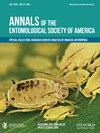传统和有机混作玉米农业生态系统中杂交和地方玉米植物寄主寄生蜂的适宜性
IF 1.8
3区 农林科学
Q1 ENTOMOLOGY
引用次数: 1
摘要
摘要复合栽培与传统单一栽培对害虫和天敌的防治效果不同。在有机混作农业生态系统与单一栽培农业生态系统中,寄生蜂对受虫害危害的乡土植物和杂交种植物的反应尚不清楚。本研究的目的是通过评估有机复合栽培和传统玉米农业生态系统中地方玉米和杂交玉米小种的寄生率、寄生蜂丰度和物种组成来比较这些农业生态系统对寄生蜂的适宜性。本研究是在中美洲地区进行的,这是玉米最初驯化的地方,也是玉米害虫Dalbulus maidis (DeLong)(半翅目:蝉科)的发源地。利用地方品种和杂交品种的玉米植株在两种农业生态系统内引诱麦地那蚊卵类寄生蜂;传统的玉米单一栽培和地方品种玉米、豆类和南瓜的有机混合栽培,其中也包括杂草植物。本试验采用四种处理方法:1)有机农业生态系统内的景观处理,2)有机农业生态系统内的杂交处理,3)传统农业生态系统内的景观处理,4)传统农业生态系统内的杂交处理。在两种农业生态系统中均发现了以微黄蜂Paracentrobia sp.(膜翅目:赤眼蜂科)数量最多的寄生蜂群落,它们攻击小蜂卵。4种处理间的寄生率和寄生蜂丰度相似。然而,在常规玉米单一栽培中,寄生蜂的丰度更高。不同农业生态系统内的诱饵植物(长白玉米和杂交玉米)在寄生蜂数量和寄生率上均无差异。本文章由计算机程序翻译,如有差异,请以英文原文为准。
Suitability of Hybrid and Landrace Maize Plants Within Conventional and Organic-Polyculture Maize Agroecosystems for Hosting Parasitic Wasps
Abstract Polycultures and conventional monoculture have different effects on insect pests and natural enemies. Little is known about the parasitoid response to landrace and hybrid plants damaged by insect pests within organic-polyculture agroecosystems vs. monoculture ones.The aim of the present study was to compare the suitability of these agroecosystems for hosting parasitic wasps by evaluating the parasitism rate, parasitoid abundance, and species composition on landrace and hybrid maize races within organic-polyculture and conventional maize agroecosystems.This study was performed within the Mesoamerican region where maize was originally domesticated and where the maize insect pest Dalbulus maidis (DeLong) (Hemiptera: Cicadellidae) originated. Maize plants of landrace and hybrid varieties were used to attract egg parasitoids of D. maidis within each of the two agroecosystems; conventional maize monoculture and an organic-polyculture of landrace maize, beans, and squash, which also included weed plants. Four treatments were conducted in this field experiment: 1) landrace-within organic agroecosystem, 2) hybrid-within organic agroecosystem, 3) landrace-within conventional agroecosystem, and 4) hybrid-within conventional agroecosystem. A community of parasitic wasps, of which the micro-wasp Paracentrobia sp. (Hymenoptera: Trichogrammatidae) was the most abundant member, was found attacking the D. maidis eggs in both agroecosystems.The parasitism rate and parasitoid abundance were similar among the four treatments. However, the abundance of parasitoids was greater in the conventional maize monoculture. Bait plants (landrace and hybrid maize) within each agroecosystem did not show differences in either parasitoid abundance or parasitism rate.
求助全文
通过发布文献求助,成功后即可免费获取论文全文。
去求助
来源期刊
CiteScore
4.90
自引率
0.00%
发文量
25
审稿时长
6-12 weeks
期刊介绍:
The Annals of the Entomological Society of America exists to stimulate interdisciplinary dialogue across the entomological disciplines and to advance cooperative interaction among diverse groups of entomologists. It seeks to attract and publish cutting-edge research, reviews, collections of articles on a common topic of broad interest, and discussion of topics with national or international importance. We especially welcome articles covering developing areas of research, controversial issues or debate, and topics of importance to society. Manuscripts that are primarily reports of new species, methodology, pest management, or the biology of single species generally will be referred to other journals of the ESA. The most important criteria for acceptance are quality of work and breadth of interest to the readership.

 求助内容:
求助内容: 应助结果提醒方式:
应助结果提醒方式:


